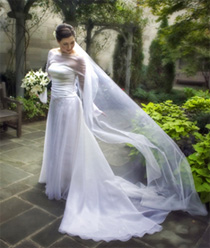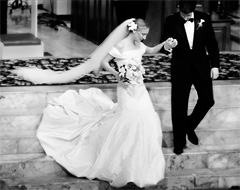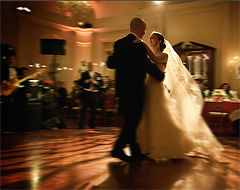
 Go Back
Go Back

The Veil Reveals
By Cornelia Powell

The veil as a costume accessory has a varied and prominent history in
women’s attire. “A veil, to a Muslim woman, has an everyday use. To a
Western woman it is out of the ordinary and thus becomes significant.”1
What has come to be known as a bridal veil in the European-American
heritage has its own unique story, borrowing from cultures of both East
and West. From the Far East, we inherit the sense of being veiled as
capturing a meditative, privileged space for a private reverie. The
Western lineage that produced the custom for wearing bridal veils was
inherited from the prestige of court dress and the allure of high
fashion, traced back to the ancient Egyptians and Romans and even
beyond. Through this Western lineage, the fabrics became even more
gossamer until the netty tulles and laces were the fabrics of choice by
brides for their ceremonial veils.
 In whatever ways the bridal traditions and
styles change and have come down to our very democratic way of dressing
today, I love the look of a woman wearing a veil for her wedding,
finishing off the ceremonial costume. The veil can be a beautiful
antique lace piece or a newly made design—a puff of tulle or a sweep of
illusion—whatever is appropriate and complements a bride’s gown, as well
as how it supports the transformation at hand.
In whatever ways the bridal traditions and
styles change and have come down to our very democratic way of dressing
today, I love the look of a woman wearing a veil for her wedding,
finishing off the ceremonial costume. The veil can be a beautiful
antique lace piece or a newly made design—a puff of tulle or a sweep of
illusion—whatever is appropriate and complements a bride’s gown, as well
as how it supports the transformation at hand.
As I worked with brides in my former shop in the late 1980s and
throughout the 1990s, many questioned the “fuss and bother” about
wedding costumes, especially the “tradition” of a bride wearing a veil. I
would share with them rather philosophically something like this:
Unlike most women in the past, you don’t dress like this everyday.
Wedding ceremonies are like playing “dress up” with an intention! You
are wearing a costume of ritual, meant to take you physically, mentally,
spiritually to another place of you—to shake you out of your norm—to
tap into the soul of change. I imagine the veil as representing the
mystery of womanhood. Wrapped in a gossamer cloud, the veil reveals the
woman.
 Barbara Tober, former longtime editor-in-chief
of Bride’s magazine, wrote in her book, The Bride, about the train of
the gown being “an extension of the presence of the bride, leaving an
aura of grandeur in her wake.”2 I loved this
image. I embellished the quote at times when brides were questioning
wearing a veil: One of my favorite bits of wedding folklore is how the
bride moved amongst her friends and family with her veil trailing
behind, leaving blessings in her wake!
Barbara Tober, former longtime editor-in-chief
of Bride’s magazine, wrote in her book, The Bride, about the train of
the gown being “an extension of the presence of the bride, leaving an
aura of grandeur in her wake.”2 I loved this
image. I embellished the quote at times when brides were questioning
wearing a veil: One of my favorite bits of wedding folklore is how the
bride moved amongst her friends and family with her veil trailing
behind, leaving blessings in her wake!
I would watch as the attentive bride listened to my stories, her look
softened as her heart opened, revealing her inner beauty. The
transformation has begun. The ritual of the bridal veil marks the
symbolic revealing as a woman sheds a layer of the past, moving closer
to becoming. End of Article
1.Carol McD. Wallace, All Dressed in White: The Irresistible Rise of the
American Wedding, (London: Penguin Books, 2004), 6.
2. Barbara
Tober, The Bride: A Celebration , (New York: Harry N. Abrams, Inc.
Publishers, 1984), 92.
© 2003 Cornelia Powell, all rights reserved.
[This is an excerpt from Cornelia's book-in-progress, Weddings of
Grace: The Bride You Want to Be, The Woman You Become—the
inspiration for this online magazine.]
As Featured on
Weddings of Grace

